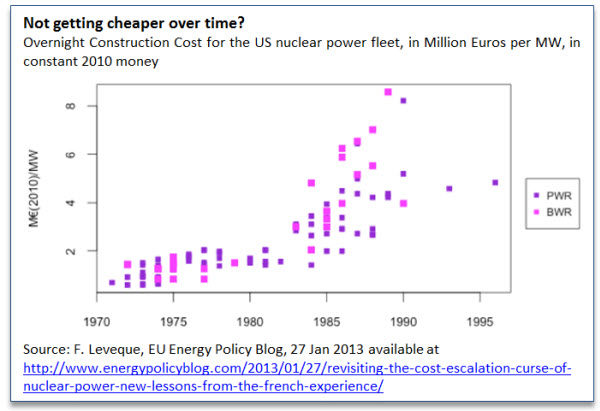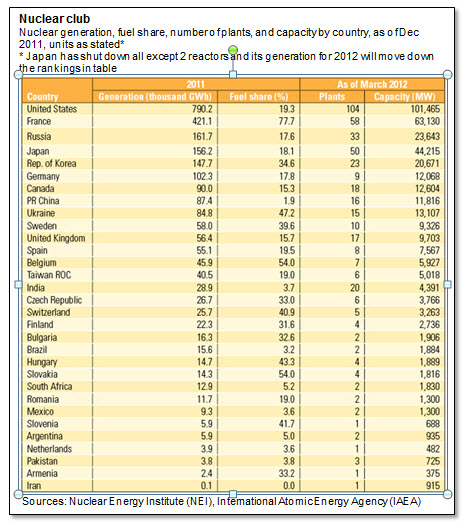A new generation of smallish reactors may give nukes a second lease on life
This is a sample article from the April 2013 issue of EEnergy Informer.
Broadly speaking, commercial nuclear reactors built over the past 6 decades have gradually gotten larger, safer, more sophisticated and more expensive. There are many reasons for this counter-intuitive trend. One would typically expect technological improvements, learning-by-doing coupled with economies of scale of mass production to result in lower per unit costs.
If the same applied to other generation technologies, nuclear would not fare too badly. But the cost of competing technologies has generally fallen, measured in per unit cost of installed capacity. The per unit cost of renewable generation, for example, has fallen dramatically, most noticeably for solar-generated technologies in the past few years.
Making matters worse for nuclear power in the US, currently with the biggest installed nuclear capacity, natural gas prices are presently so low that natural gas-fired plants now compete on operating costs with older, less efficient nuclear generation. As a result, a number of older nuclear reactors in the US are expected to be shut down before their operating licenses expire — an unimaginable scenario until natural gas prices began to fall in the US due to a supply glut.

But even in Europe and Japan, where natural gas prices are significantly higher than in the US, few private investors are building new nuclear plants. The only two advanced reactors currently under construction in Europe, one in France and one in Finland, are both behind schedule and over budget.
In February 2013, TVO, the owner of Olkiluoto 3, the first European generation III nuclear reactor, announced that the unit will probably not commence operation before 2016. The latest delay was blamed on failure to get timely regulatory approval for the reactor’s instrumentation and control equipment. This, coming on top of several prior disappointments have blown out the construction time by several years, and led to billions of Euros in budget over runs.
Against this backdrop, many within the nuclear community believe that the future of commercial atom lies in small, standardized modular reactors — that can be mass produced in a factory and shipped to site for assembly. They are referred to SMRs, for small modular reactors.
The idea is anything but new. The concept has proven feasible since USS Nautilus, the first US nuclear powered submarine, went into service in 1955 with a 10 MW reactor on board. The US navy found nuclear powered submarines reliable, durable, safe, and quiet — a big plus during the cold war years. They did not need to surface for air, could remain submerged for prolonged periods with infrequent need for refueling. And there are no reports of accidents or fatalities for sailors who live within a few feet of the reactors. According to Lloyd’s Register in London, over 600 nuclear reactors have been in operation since then with an estimated 200 in the maritime environment.

How small must an SMR be? There is no firm definition, but anything as small as 10 to 35 MW to 300 MW or larger qualifies. The International Atomic Energy Agency, (IAEA), based in Vienna, Austria, puts the upper limit at 700 MW — something that would probably be too large to manufacture and ship to site. Using this definition, IAEA says there are currently125 SMRs in operation world-wide with 17 under construction in 28 countries.
A number of manufacturers are prospecting in what many believe could be a commercially viable niche, especially for developing countries that would benefit from the assembly of prefabricated modules on site. A handful of companies including Westinghouse, Babcock & Wilcox’s (B&W) Holtec, NuScale Power and others are pursuing prototypes expected to become operational in mid 2020s.
Among the most advanced is the B&W’s mPower SMR, a 180 MW advanced pressurized water reactor (PWR). Just how advanced is it? In February 2013, the Tennessee Valley Authority (TVA) signed a contract to support Nuclear Regulatory Commission (NRC) review of a construction permit application for an mPower SMR at its Clinch River Site in Oak Ridge, TN. TVA expects to submit a construction permit to the NRC in 2015, with a unit in operation as early as 2022. This represents a significant milestone for SMRs — and perhaps a second lease on life for commercial nuclear energy.
Westinghouse, which is owned by Toshiba, is working with a consortium of utilities, including Ameren Missouri and few others, on a 225 MW pressurized water reactor.
Others are pursuing similar dreams. According to an article in The Financial Times (15 Feb 2013), Russia is building the first of what might be a flotilla of floating nuclear power plants, each with a 35 MW reactor, that can anchor offshore and supply enough power for a community of 20,000. Just plug and go and hope no hurricanes or tsunamis come your way.

